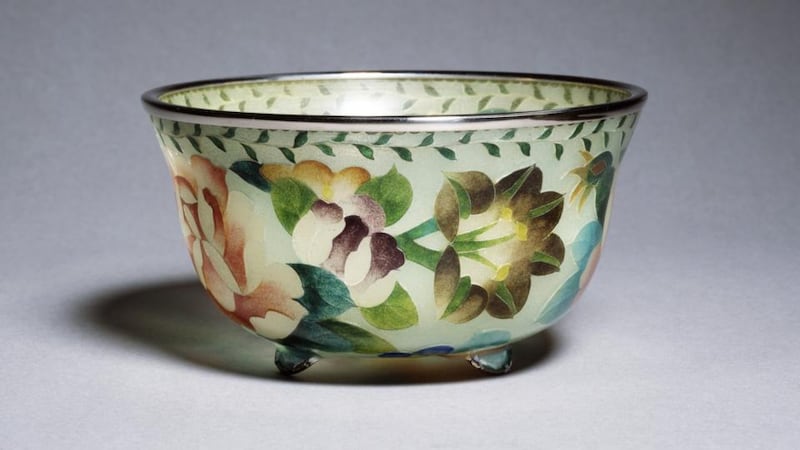Blame mass production, perhaps, but the processes by which once unique, costly and highly specialised objects can now be enjoyed by everyone, have turned these things into cliches of themselves, robbing them of their ability to inspire awe and wonder.
Take Japanese cloisonné. Think of the thousands of vases for sale in tacky trinket shops, patterned with chrysanthemums, birds and dragons. Then take a look at the real thing, and feel the processes of time at play in a piece that may have taken months of intricate skill and dedicated polishing to create.
Spend a little time at Seven Treasures, an exhibit on tour from the Victoria and Albert Museum and now at Dublin's Chester Beatty Library. You just might find that it restores that capacity for an object, however tiny, to engender a sense of deep delight. The title alludes to the characters for shippo, the Japanese term for enamel, which refers to the seven treasures of gold, silver, coral, lapis lazuli and other precious stones.

The Japanese golden age
Most of the pieces in this exhibition date from the Japanese golden age, between 1880 and 1910. But cloisonné itself is a far more ancient art, made by creating little wire “cages” to contain powdered glass, which is then fired in a kiln before being polished. It appears in the jewels of the Egyptian pharaohs, and in Anglo-Saxon brooches, and can be seen around the gilt band of our own eighth-century Ardagh chalice.
In a telling example of how foreigners tend to be typecast, one influential type of gemstone cloisonné was spread across Europe by the migrating “barbarians”.
It's unclear why three-dimensional cloisonné pieces were not abundant in Japan before the 1840s, says Gregory Irvine, curator of Japanese objects at the Victoria and Albert in London. Seven Treasures does include some earlier pieces, including sword guards, but the real explosion in making took place, as Chester Beatty curator Laura Muldowney explains, when Japan opened up to international visitors and cloisonné became a major export.
Not everyone realised exactly what they were buying at the time. When the Victoria and Albert began collecting enamels in 1867, buying pieces from the Paris International exhibition, Irvine says it paid “phenomenally high prices, like everyone else, because we weren’t sure exactly what they were”. Many of these early collectors believed they were buying much older pieces, but adventurers, including the writer Rudyard Kipling, who travelled to the studio of Namikawa Yasuyuki in 1904, realised the true value of what was going on.
“I saw a man who had only been a month over the polishing of one little vase five inches high,” Kipling recounted. “When I am in America he will be polishing it still, and the ruby-coloured dragon that romped on a field of lazuli, each tiny scale and whisker a separate compartment of enamel, will be growing more lovely.”
In Japanese hands, enamel work came to embody ideas of contemplation, time and nature. Some of the intricate pieces are only centimetres high, and so the Chester Beatty exhibition invites you to marvel in the miniature. This, as the French philosopher Gaston Bachelard wrote in his lovely book The Poetics of Space, "is one of the refuges of greatness", encouraging you to focus deeply. "The minuscule, a narrow gate, opens up an entire world."
Here that world includes a vase in which a delicate green leaf gently flicks over the rim to grow down into the interior; the filigree of butterfly wings; and nanako (fish roe), goldfish glowing with an underlay of silver and swimming across little twin vases.
An experimental streak
As the exhibition develops, you can see how the makers, perhaps almost bored by their brilliance, began to experiment, making enamel works that look like Dutch Delftware, adding silvering and blurring outlines. In Chester Beatty director Fionnuala Croke's favourite piece, a plique-à-jour bowl from the Ando studio, the makers copied a French technique to dissolve the metal base. All that remains is a translucent shell of glowing flowers.
The story of these works is also the story of the Victorian and early 20th-century travellers whose collections formed the basis of some of the world’s great museums. Some critics have called it plundering, although the destruction at sites such as Nineveh in Iraq have caused a re-evaluation of the custodial role of museums.
It’s a debate that will continue, but undoubtedly what we understand as art and design history is as much based on what has been collected and preserved as what remains in situ.
The pieces in Seven Treasures were largely made for export, and so debates about repatriation don't apply. Many of the objects come from a donation by Edwin Davies, a businessman and philanthropist and the owner of Bolton Wanderers football club.
There are also connections between the Victoria and Albert and the Chester Beatty in parallel holdings, such as the famous 16th-century Mughal Court “Minto Album”, from which 19 of the 40 folios are at the Chester Beatty, and 21 in London.
Before establishing his collection in Ireland in 1950, the New York-born Alfred Chester Beatty also gifted many pieces to the Victoria and Albert. Irvine says the museum felt it was “a great opportunity to collaborate with one of the finest collections” when touring this exhibition.
“It’s been fabulously displayed,” he says. “I’ve seen it in all the other venues [it has toured to], and this has excelled.”
It’s a fascinating glimpse into a gorgeous jewelled world, where time spent looking is rewarded. Even – especially – at the small.













